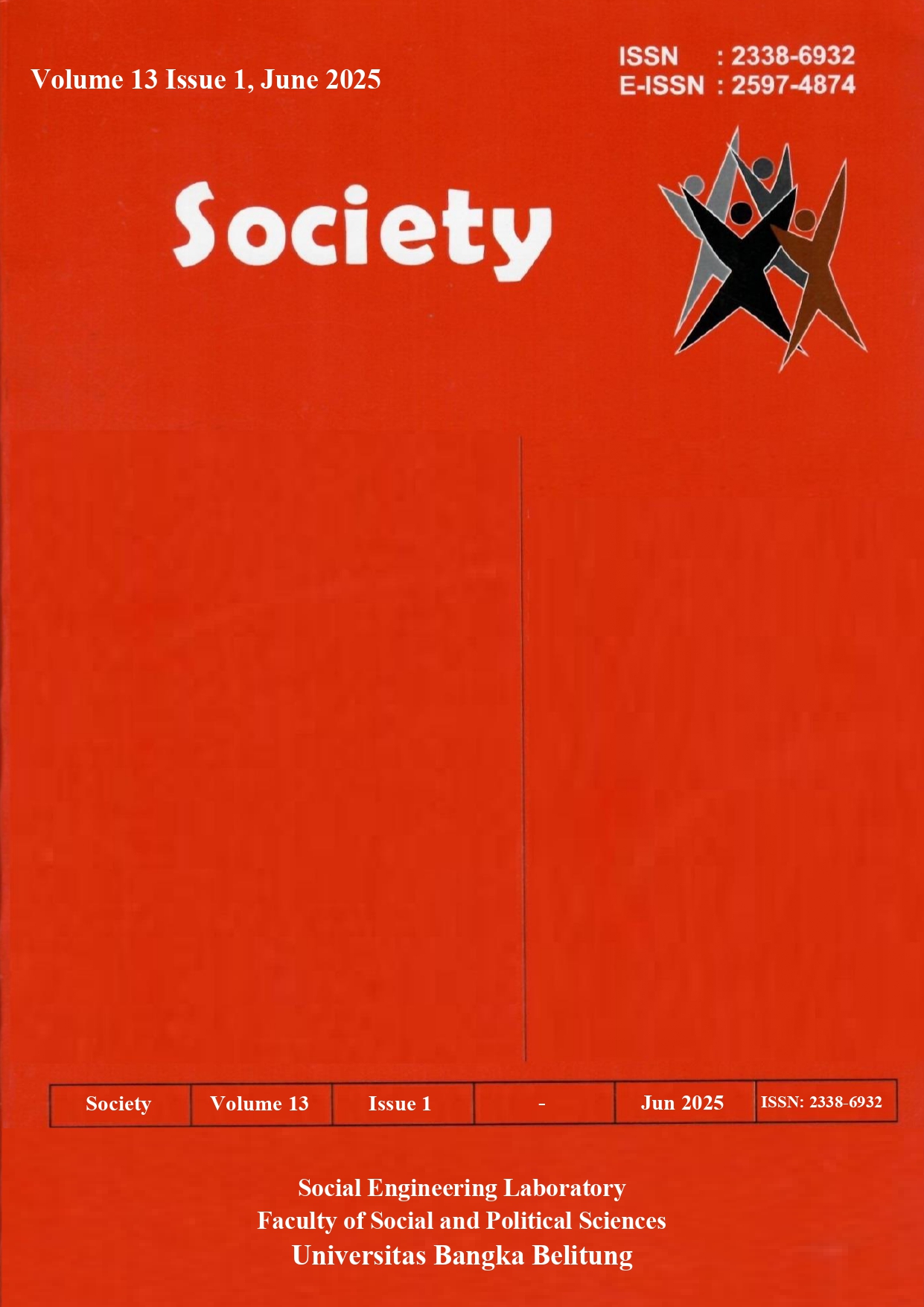Abstract
The increasing deployment of Indonesian migrant workers (PMI) to various destination countries, especially in Asia and Africa, has generated substantial income inflows for families back home. However, low financial literacy, limited access to formal financial services, and a tendency toward short-term consumption often undermine this economic potential. This study investigates financial literacy and inclusion's influence on investment interest among Indonesian migrant workers. Utilizing a quantitative approach with Partial Least Squares Structural Equation Modeling (PLS-SEM), data were collected from 200 respondents through an OECD-adapted questionnaire covering financial knowledge, behavior, attitudes, and service accessibility. The findings indicate that financial literacy significantly affects investment interest (? = 0.386; p = 0.013), suggesting that enhanced financial competence increases the propensity to invest. Similarly, financial inclusion also exerts a significant positive influence (? = 0.351; p = 0.030), revealing that improved access to financial products and services, such as savings, insurance, and digital investment platforms, encourages migrant workers to engage in productive financial activities. These results highlight the importance of targeted financial education programs and inclusive financial infrastructures to strengthen the long-term economic resilience of returning migrant workers and their families. Future research should explore additional moderating variables such as digital platform adoption, migration duration, and sociocultural dynamics to enrich the understanding of investment behavior within this demographic.
References
Abdillah, W., & Hartono, J. (2015). Partial least square (PLS): Alternatif struktural equation modeling (SEM) dalam penelitian bisnis. Penerbit Andi.
Arianti, B. F. (2018). The Influence of Financial Literacy, Financial Behavior and Income on Investment Decision. EAJ (Economic and Accounting Journal), 1(1), 1–10. https://doi.org/10.32493/eaj.v1i1.y2018.p1-10
Aribawa, D. (2016). Pengaruh Literasi Keuangan Terhadap Kinerja Dan Keberlangsungan UMKM di Jawa Tengah. Jurnal Siasat Bisnis, 20(1), 1–13.
Arikunto, S. (2019). Prosedur penelitian suatu pendekatan praktik. Rineka Cipta.
Badan Perlindungan Pekerja Migran Indonesia. (2023). Data penempatan dan pelindungan Pekerja Migran Indonesia periode Desember 2023. https://bp2mi.go.id/statistik-detail/data-penempatan-dan-pelindungan-pekerja-migran-indonesia-periode-desember-2023
Badan Pusat Statistik. (2023). Februari 2023: Tingkat pengangguran terbuka (TPT) sebesar 5,45 persen dan rata‑rata upah buruh sebesar Rp2,94 juta per bulan. https://www.bps.go.id/pressrelease/2023/05/05/2001/februari-2023-tingkat-pengangguran-terbuka--tpt--sebesar-5-45-persen-dan-rata-rata-upah-buruh-sebesar-2-94-juta-rupiah-per-bulan.html
CEIC Data. (2023). Indonesia GDP per Capita (USD). https://www.ceicdata.com/en/indicator/indonesia/gdp-per-capita
Filipiak, U., & Walle, Y. M. (2015). The Financial Literacy Gender Gap: A Question of Nature or Nurture? In Discussion Paper Series, Courant Research Centre: Poverty, Equity and Growth (CRC-PEG) (Issue 176). Georg-August-Universität Göttingen.
Fornell, C., & Larcker, D. F. (1981). Evaluating Structural Equation Models with Unobservable Variables and Measurement Error. Journal of Marketing Research, 18(1), 39–50. https://doi.org/https://doi.org/10.2307/3151312
Ghozali, I. (2015). Structural Equation Modeling: Metode Alternatif dengan Partial Least Square (PLS) (4th ed.). Badan Penerbit Universitas Diponegoro.
Hair, J. F., Hult, G. T. M., Ringle, C. M., & Sarstedt, M. (2017). A Primer on Partial Least Squares Structural Equation Modeling (PLS-SEM). SAGE.
Hussein, A. S. (2015). Penelitian Bisnis dan Manajemen Menggunakan Partial Least Square (PLS) dengan SmartPLS 3.0. Fakultas Ekonomi dan Bisnis Universitas Brawijaya.
Katadata. (2024). Average salaries of Indonesian citizens working in Asia, highest in South Korea. Katadata Databoks. https://databoks.katadata.co.id/en/education/statistics/67b2cd6aaea8a/average-salaries-of-indonesian-citizens-working-in-asia-highest-in-south-korea
Klapper, L., Lusardi, A., & Oudheusden, P. (2015). Financial Literacy Around The World: Insight From The Standard And Poor Rating Service Global Financial Literacy Survey. GFLEC.
Lestari, E. P., Putri Pertiwi, N. L., Alimuddin, A., & Asbihani, D. (2023). Minat Investasi Pekerja Migran Indonesia Dalam Meningkatkan Ketahanan Ekonomi Keluarga Di Lampung Timur. FINANSIA : Jurnal Akuntansi Dan Perbankan Syariah, 6(1), 89–104. https://doi.org/10.32332/finansia.v6i1.6630
Logica Research. (2024). Future of Money insights kit. https://logicaresearch.com/future-of-money/
Mediana, E. N., Sundari, S., Haetami, & Purwantoro, S. A. (2023). Upaya Pembinaan Purna Pekerja Migran Indonesia untuk Mendukung Ekonomi Pertahanan. IRK Journal of Innovation Research and Knowledge, 2(9).
Nurfadilah, Wahyuni, I., & Subaida, I. (2022). Pengaruh Pengetahuan Investasi dan Kemajuan Teknologi terhadap Keputusan Investasi dengan Minat Investasi sebagai Variabel Intervening. Jurnal Mahasiswa Entrepreneur (JME), 1(8), 1630–1644. https://ojs.unars.ac.id/index.php/jme/article/view/2209/1691
OECD/INFE. (2018). Financial Inclusion and Consumer Empowerment in Southeast Asia. OECD. http://www.oecd.org/finance/financial-inclusion-and-consumerempowerment-in-southeast-asia.pdf
Otoritas Jasa Keuangan–Dewan Nasional Keuangan Inklusif. (2018). Youth Finsight Survey 2018: Digital financial behavior of Indonesian millennials. https://snki.go.id/wp-content/uploads/2023/10/Youth-Finsights-2.0-Report.pdf
Otoritas Jasa Keuangan. (2022). Strategi Nasional Literasi Keuangan Indonesia (SNLKI) 2021 - 2025. https://ojk.go.id/id/berita-dan-kegiatan/publikasi/pages/strategi-nasional-literasi-keuangan-indonesia-2021-2025.aspx
Pearce, D., & Ruiz Ortega, C. (2012). Financial inclusion strategies: Reference framework. https://documents.worldbank.org/curated/en/801151468152092070/pdf/787610WP0P144500use0only0900A9RD899.pdf
Putri, N. M. D. R., & Rahyuda, H. (2017). Pengaruh Tingkat Financial Literacy dan Faktor Sosiodemografi terhadap Perilaku Keputusan Investasi Individu. E-Jurnal Ekonomi Dan Bisnis Universitas Udayana, 6(9), 3407–3434. https://doi.org/10.24843/eeb.2017.v06.i09.p09
Sarma, M. (2012). Index of Financial Inclusion – A measure of financial sector inclusiveness. Centre for International Trade and Development, Jawaharlal Nehru University.
Septiani, R. N., & Wuryani, E. (2020). Pengaruh Literasi Keuangan dan Inklusi Keuangan terhadap Kinerja UMKM di Sidoarjo. E-Jurnal Manajemen, 9(8), 3214–3236. https://doi.org/10.24843/ejmunud.2020.v09.i08.p16
Sugiyono. (2016). Metode penelitian kuantitatif, kualitatif, dan R&D (23rd ed.). Alfabeta.
Sun, Y., & Siagian, P. (2015). Financial inclusion in Indonesia and its challenges. Pertanika Journal of Social Sciences and Humanities, 23(May), 85–96.
Susanti, S., Hasan, M., & Ihsan Said Ahmad, M. (2018). Faktor-Faktor yang Mempengaruhi Minat Mahasiswa Berinvestasi di Galeri Investasi Universitas Negeri Makassar. In Prosiding Seminar Nasional Pendidikan Ekonomi 2018.
Trading Economics. (2024). Indonesia — age dependency ratio (% of working-age population). https://tradingeconomics.com/indonesia/age-dependency-ratio-percent-of-working-age-population-wb-data.html
Ummah, B. B., Nuryartono, N., & Anggraeni, L. (2021). Analisis Inklusi Keuangan dan Pemerataan Pendapatan di Indonesia. Jurnal Ekonomi Dan Kebijakan Pembangunan, 4(1), 1–27.
Viana, E. D., Febrianti, F., & Dewi, F. R. (2022). Literasi Keuangan, Inklusi Keuangan dan Minat Investasi Generasi Z di Jabodetabek. Jurnal Manajemen Dan Organisasi, 12(3), 252–264. https://doi.org/10.29244/jmo.v12i3.34207
Vivero, M. G., & DeLisle, R. J. (2022). The Effect of Income Inequality on Stock Market Participation: Evidence from US Households and the Adoption of the Medicaid Expansion Under the Affordable Care Act. SSRN Electronic Journal. https://doi.org/10.2139/ssrn.4137764
World Bank. (2024a). Age dependency ratio (% of working-age population) – Indonesia. World Development Indicators. https://data.worldbank.org/indicator/SP.POP.DPND?locations=ID
World Bank. (2024b). Population, total – Indonesia. World Development Indicators. https://data.worldbank.org/indicator/SP.POP.TOTL?locations=ID
Yanti, W. I. P. (2019). Pengaruh Inklusi Keuangan dan Literasi Keuangan terhadap Kinerja UMKM di Kecamatan Moyo Utara. Jurnal Manajemen Dan Bisnis, 2(1). https://doi.org/10.37673/jmb.v2i1.305

This work is licensed under a Creative Commons Attribution-NonCommercial-ShareAlike 4.0 International License.
Copyright (c) 2025 Sri Lestari Pujiastuti, Imas Maesaroh, Andriyansah Andriyansah






